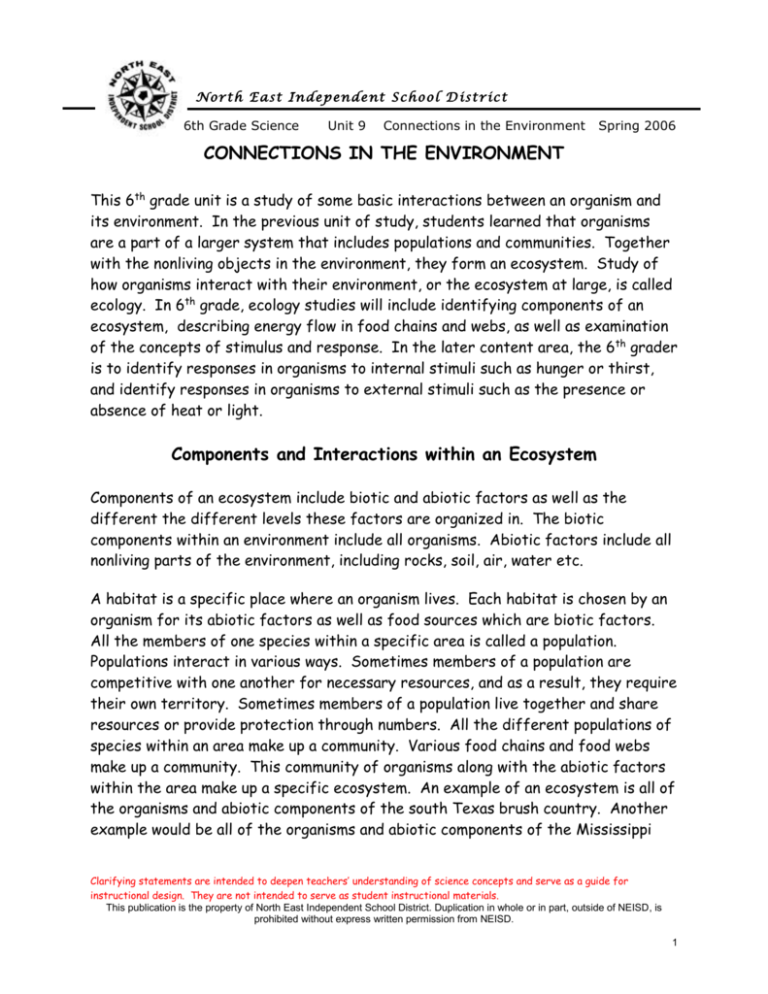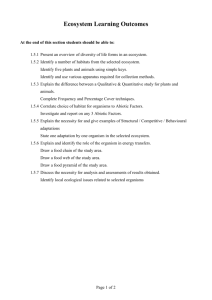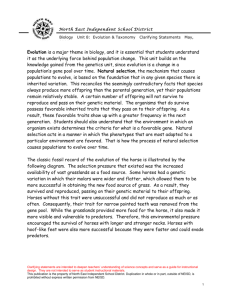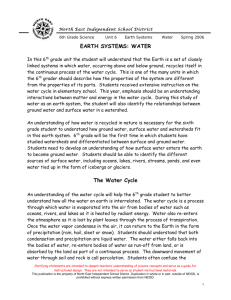Environment - North East Independent School District
advertisement

N o r t h E a st I n d ep en d e nt S c h o o l D i st ric t 6th Grade Science Unit 9 Connections in the Environment Spring 2006 CONNECTIONS IN THE ENVIRONMENT This 6th grade unit is a study of some basic interactions between an organism and its environment. In the previous unit of study, students learned that organisms are a part of a larger system that includes populations and communities. Together with the nonliving objects in the environment, they form an ecosystem. Study of how organisms interact with their environment, or the ecosystem at large, is called ecology. In 6th grade, ecology studies will include identifying components of an ecosystem, describing energy flow in food chains and webs, as well as examination of the concepts of stimulus and response. In the later content area, the 6th grader is to identify responses in organisms to internal stimuli such as hunger or thirst, and identify responses in organisms to external stimuli such as the presence or absence of heat or light. Components and Interactions within an Ecosystem Components of an ecosystem include biotic and abiotic factors as well as the different the different levels these factors are organized in. The biotic components within an environment include all organisms. Abiotic factors include all nonliving parts of the environment, including rocks, soil, air, water etc. A habitat is a specific place where an organism lives. Each habitat is chosen by an organism for its abiotic factors as well as food sources which are biotic factors. All the members of one species within a specific area is called a population. Populations interact in various ways. Sometimes members of a population are competitive with one another for necessary resources, and as a result, they require their own territory. Sometimes members of a population live together and share resources or provide protection through numbers. All the different populations of species within an area make up a community. Various food chains and food webs make up a community. This community of organisms along with the abiotic factors within the area make up a specific ecosystem. An example of an ecosystem is all of the organisms and abiotic components of the south Texas brush country. Another example would be all of the organisms and abiotic components of the Mississippi Clarifying statements are intended to deepen teachers’ understanding of science concepts and serve as a guide for instructional design. They are not intended to serve as student instructional materials. This publication is the property of North East Independent School District. Duplication in whole or in part, outside of NEISD, is prohibited without express written permission from NEISD. 1 N o r t h E a st I n d ep en d e nt S c h o o l D i st ric t 6th Grade Science Unit 9 Connections in the Environment Spring 2006 river delta. These ecosystems and all others in the world are collectively referred to as the biosphere. The ultimate source of energy for the biosphere is the sun. There are three groups of organisms in any ecosystem that rely on the radiant energy of the sun. They are producers, consumers and decomposers. Producers take in energy from the sun. Grasses, shrubs, and trees are examples of producers. They are called producers because they can make, or produce, their own food. Consumers get their energy from eating, or consuming, other organisms. Animals are examples of consumers. When a consumer eats a producer or another animal that has eaten a producer, it is getting some of that original radiant energy provided by the sun. Herbivores are a class of animals that eat only vegetable matter. Carnivores are a class of animals that eat only meats. Omnivores eat both. Decomposers, such as bacteria, obtain their nutrients by breaking down wastes and the remains of other, dead organisms. The path or flow of energy in an ecosystem is called a food chain. A food chain always starts with a producer. It is followed by all the animals that eat the producer and then the other animals that eat each other in the order that the process occurs. Below is an example of a simple food chain. It is important for students to know that the arrows always point in the direction that the energy is moving. In addition, they should know that not all energy is transferred. Some of it is lost to the environment as heat. Clarifying statements are intended to deepen teachers’ understanding of science concepts and serve as a guide for instructional design. They are not intended to serve as student instructional materials. This publication is the property of North East Independent School District. Duplication in whole or in part, outside of NEISD, is prohibited without express written permission from NEISD. 2 N o r t h E a st I n d ep en d e nt S c h o o l D i st ric t 6th Grade Science Unit 9 Connections in the Environment Spring 2006 Example of a simple food chain with arrows showing energy flow: Many consumers do not just eat one organism. Many organisms feed off of a variety of food. Interconnected food chains form food webs, which are more complex. They are also more accurate at describing how many organisms interact within the environment. Students should understand that the food web provides a more complete picture of the flow of energy in an ecosystem. In the case of an animal that only eats one kind of food, that animal is at risk if the food supply is destroyed. A good example of this would be the Giant Panda. They only eat bamboo. The bamboo forests of Asia are rapidly decreasing. If the bamboo is no longer available, then Giant Pandas will become extinct. Clarifying statements are intended to deepen teachers’ understanding of science concepts and serve as a guide for instructional design. They are not intended to serve as student instructional materials. This publication is the property of North East Independent School District. Duplication in whole or in part, outside of NEISD, is prohibited without express written permission from NEISD. 3 N o r t h E a st I n d ep en d e nt S c h o o l D i st ric t 6th Grade Science Unit 9 Connections in the Environment Spring 2006 Stimulus and Response 6th grade students have not been exposed to stimulus and response before. It is common for students to confuse the two. Students need to be able to differentiate between the stimulus and response as well as classify the stimulus as internal or external. Anything that causes a response in a living organism is called a stimulus. If the stimulus comes from within the organism, then it is internal. An example would be hunger. If the stimulus comes from the environment, then it is an external stimulus. An example would be jumping into a swimming pool and then feeling cold. These survival responses help organisms find food, avoid predation, find a place to live, hibernate when the seasons change, grow towards the light, and so forth. Plants respond to stimuli such as gravity, light and touch. Plants grow towards light. Some plants respond to touch. Plants known as climbers will attach to a fence vine for support as they grow. A Venus flytrap plant will snap shut when an insect lands on it. Each of these are examples of plants responding to an external stimulus. Hibernation and migration are responses of animals to seasonal changes. These would also be responses to external stimuli. The following chart provides more examples: Organisms turtle human opossum cactus plant pill bug plant dog human Stimulus scared by noise dry mouth feels threatened rain lack of water damp ground light heat need for oxygen Response retreats into shell drinks water plays dead blooms quickly wilts moves towards it grows towards it begins to pant breathing Internal or External ? external internal external external internal external external external internal Clarifying statements are intended to deepen teachers’ understanding of science concepts and serve as a guide for instructional design. They are not intended to serve as student instructional materials. This publication is the property of North East Independent School District. Duplication in whole or in part, outside of NEISD, is prohibited without express written permission from NEISD. 4











